-
Engine3.0L Turbodiesel V6
-
Power254 HP / 443 LB-FT
-
Transmission8-Speed Automatic
-
0-60 Time7.7 Sec
-
Top Speed130 MPH
-
DrivetrainAll-Wheel Drive
-
Engine PlacementFront
-
Curb Weight4,916 LBS
-
Seating2+3+2
-
Cargo82.7 CU FT (Max.)
-
MPG21 City / 26 HWY
-
Base Price$50,985
At the dawn of the great SUV age, just after the original Ford Explorer crawled out of the petroleum ooze and began to rule the roads, Land Rover brought its Discovery stateside. It was perfectly suited to American tastes, packing a V8 engine and safari-ready styling, allowing it to telegraph sophistication while navigating the asphalt jungle. It was basically a Range Rover under the skin, with updated looks and a lower price point without sacrificing much off-road capability. For the next 23 years, the Discovery evolved into softer and softer forms, leading to the BMW-ified Discovery II, the LR3, and then the LR4 that directly preceded the 2017 Discovery. By trading off-road pretense for on-road civility, the LR4 sold better than ever.
But rather than softening the LR4 up any more, Land Rover hit the reset button. The 2017 Discovery starts over with its original name but a new philosophy: beginning with a solid foundation of on-road competency and adding back enough off-road capability to pass the laugh test. At least, that's the billing.
To find out how it all works in the real world, I went to southern Utah in the middle of winter. Rain-shrouded mesas and snowy ponderosa pine forests were the backdrop for a broad survey of light off-roading tasks, like scrambling up solid but gently sloping rock faces and blasting through wet sand dunes. Perhaps more importantly, I did long highway stretches through vast open spaces of the Southwest. It feels like a better road machine than its predecessors, partly because Land Rover's astutely perceived the ascendancy of the crossover and built a vehicle for that reality. Onboard WiFi is in, the Camel Trophy is out.

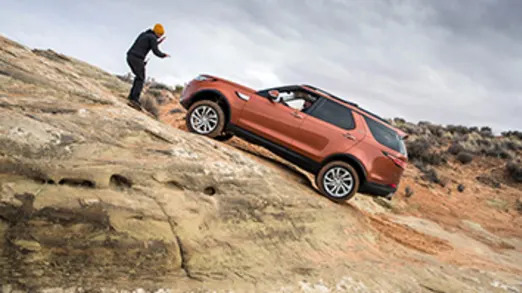
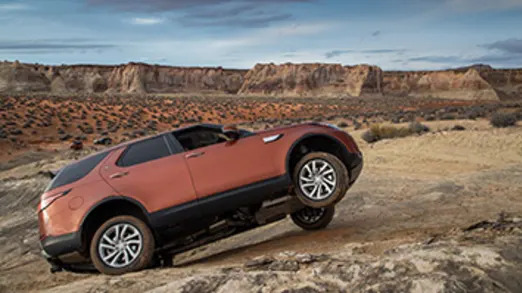
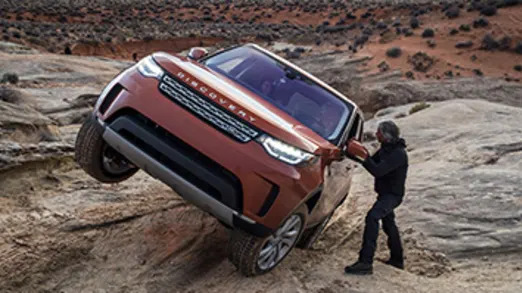
The result is a better Discovery for nearly everyone, and the only casualty is the sentimental baggage attached to a storied name. Even the styling pays only the most trivial deference to its ancestor. The famous multi-window safari roof has evolved into a halfhearted little vestigial hump. The clamshell hood is a more successful adaptation of an original Discovery design feature, spilling down into generously flared fenders in a couple of lovely steps. On the rear hatch, there's a familiar asymmetrical license plate relief and sexy, slim taillights. They do a bit to relieve the eye of the tucked-in hindquarters, which tumble inward from the rear wheels. Surely this is to pull the sheetmetal as tightly and economically around the structure as possible for better aero, but it makes the Discovery look pinched in the rear.
Speaking of structure, the 2017 Discovery doesn't have much in common with the smaller, Evoque-based Discovery Sport. The signature unibody-plus-frame construction of Discoveries past is gone, so the unibody 2017 Discovery is up to 1,000 pounds lighter than its immediate predecessor – a reflection of the reality that older Discoveries lugged around heavy equipment that buyers simply didn't use. It's also 5.5 inches longer than the LR4, with a 1.5-inch-longer wheelbase, and it's marginally lower overall. In a parallel with the original, the new Discovery's aluminum-heavy structure is shared with the full-size Range Rover and the Range Rover Sport. It's stiff as a British upper lip and won't talk about its feelings.
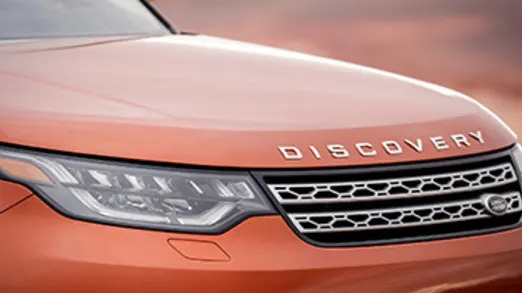
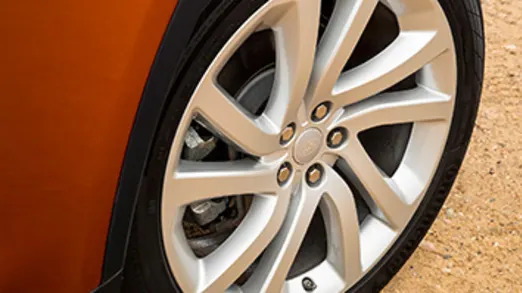
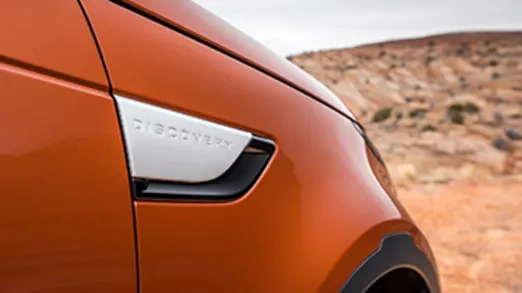
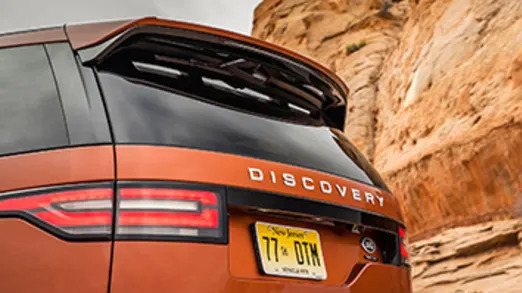
I do have some feelings about the engine choices. The familiar 340-horsepower, supercharged gasoline 3.0-liter V6 is present, as it is in so many JLR products these days. With 332 lb-ft of torque on hand, the blown gas V6 might move the Discovery around effortlessly, but the charismatically torquey turbodiesel V6 is the one that wins you over. Its raw numbers – 254 hp and 443 lb-ft of torque – don't convey it, but the engine is a sweetheart. At a roughly $2,000 premium, the quiet-idling diesel is a worthwhile upgrade. ( The $2,000 upcharge represents the difference in price between the HSE Si6 gas version and the HSE Td6 diesel. The Td6 engine isn't available in the base SE trim. – Ed.)
The only transmission available is the ZF eight-speed automatic, a competent slushbox used in just about everything that matters. In Drive, it's a little protective of fuel economy numbers and loath to do much except upshift as quickly as possible. It wakes up a bit in Sport. With either engine, passing big trucks on the wide-open Utah highway requires only a moderate stab of the throttle and a couple of manual downshifts with the paddles. I spent most of my time in a diesel and observed 25 mpg overall, according to the trip computer.
All-wheel drive is standard, but a low-range transfer case is an option on certain trim levels. That's nothing new; the LR4 offered the same sensible choice to buyers. The low-range option, and what the Discovery can do with it, lend the whole shebang a whiff of go-anywhere legitimacy. Opting for the two-speed 'box gives a standard 50-50 torque split that is then varied electronically depending on conditions, and the truck can shift to low on the fly at up to 37 mph. The single-speed transfer case is a Torsen unit that can vary the torque split to as much as 62 percent front or 78 percent rear; more importantly for efficiency, it offers a 37-pound weight savings.
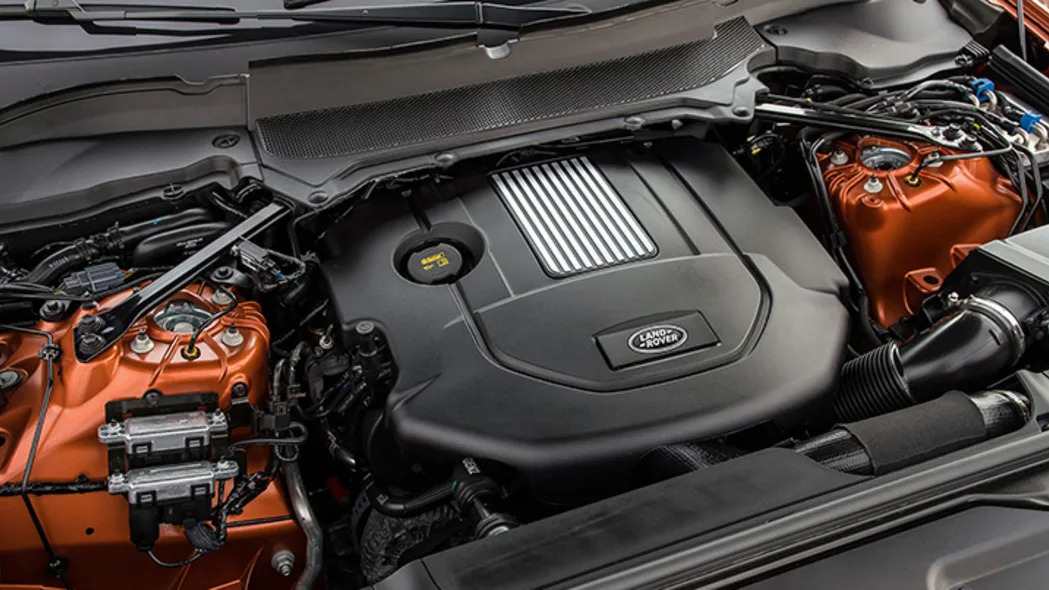
On the dunes, locking it in low range for the gnarlier stuff reveals the real Achilles' heel of the Discovery: its very on-road oriented tires (Goodyear Eagles, on 20- or 21-inch wheels). I'll hazard a guess that buying knobbier rubber would do more for the Discovery's real-world grip than the low-range case, based on a slightly hairy snow-bound mountain pass encountered along the way. Whatever surface we were on – the pink sand, a muddy and rutted primitive track, or that icy mountain road – the Discovery's Terrain Response 2 electronic traction management system did much of the heavy lifting. That includes the All-Terrain Progress Control system, which is essentially a cautious off-road cruise control system that works hard to control wheelspin at the expense of glacial forward progress. Full autonomous off-roading is surely in the company's future, but the ability to take a nap while your Land Rover works its way to the top of the mountain seems pretty uninteresting.
The optional air suspension provides a useful range of height settings, just like on other JLR products so equipped. From the standard height, it can kneel by a full 2.36 inches when stopped or rise up to 2.95 inches in full off-road lift mode at low speeds. The ride quality in all situations is composed – there's not much head-tossing side-to-side movement, washboard gyrations are well damped, and it doesn't wallow on-road. The suspension and seats easily provide a few hours' worth of comfort before you need to stop for a tea break.
From the front chairs, the view is typical Land Rover, perhaps even typical Range Rover. Since there's a lot of the same DNA here, it's tough to tell just by looking around the cabin that a Range Rover Sport sits higher on the food chain than the Disco in HSE Luxury trim. The futuristic steering wheel and the center console exude a chunky sophistication. The InControl Touch Pro 10.0-inch touchscreen is well integrated, responsive, and intuitive, although its presence means the loss of some convenient physical buttons.


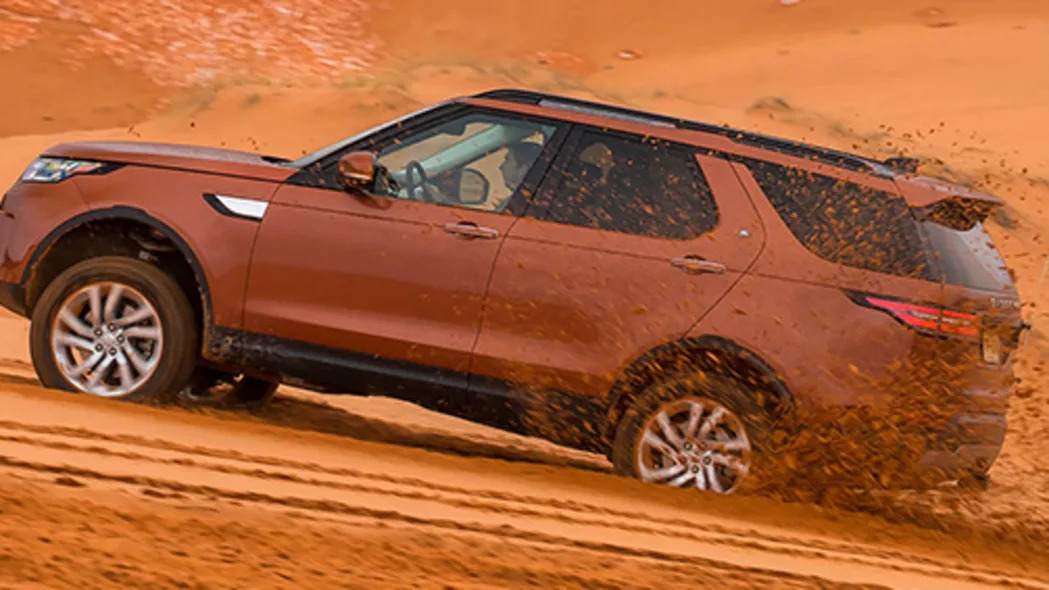
Need to charge a device? There are enough power ports inside – up to nine USB and six 12-volt outlets – to power an Apple Store. There might be 15 storage cubbies inside, if I counted correctly before becoming fascinated by the rear cargo area's party tricks. There are power-folding seat controls back there (the seats can also be operated from the InConnect Touch smartphone app, in case you need to fold down the seats from another county) and a power-operated fold-down tailgate thing since the previous model's split rear hatch has been replaced by a one-piece unit. True to its billing, that tailgate is a great place to sip tea while sheltered from the rain by the overhanging hatch. Behind the tailgate is either a cavernous space or a two-place third-row seat, depending on vehicle configuration and options. With all seats folded flat, there's 82.7 cubic feet, and behind the second row there's 45. That third row is the best you'll find in a Land Rover product, comfortable enough for large children or moderately sized adults.
These capabilities – how the Discovery conquers obstacles of human and nonhuman cargo – are much more important than the window dressing that is the new Discovery's off-road numbers. It can ford even deeper water than the outgoing LR4, actually a rather incredible 7.9-inch increase in wading depth, but Land Rover may as well have taught the SUV to speak Sanskrit. I romped through a few puddles for the hell of it, but I can assure you that if a customer-owned 2017 Discovery finds itself in 35.4 inches of water, there's likely been a tsunami. The same goes for the increased approach and departure angles and improved ground clearance: they're a thin veneer of reassurance rather than a heavy burden.
At $50,985 to start, the 2017 Discovery undercuts the 2017 Mercedes-Benz GLE350 by $2,000, and the lowest-spec 2017 BMW X5 sDrive35i by $5,500 (which is rear-drive), but it's a hair more expensive than the Audi Q7. That being said, the Discovery's third row does a better job of accommodating adults than any of these, as it should being the most specialized people-hauler in the Land Rover lineup. The Range Rover Sport's third row is most definitely an occasional-use proposition, as anyone cross-shopping the two Land Rover seven-seaters will quickly discover.
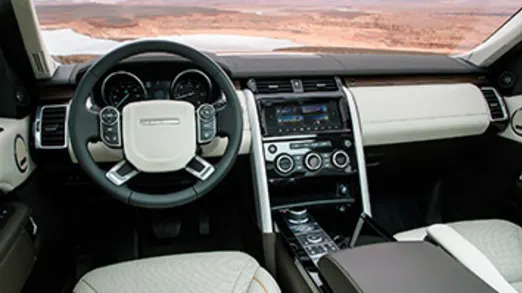
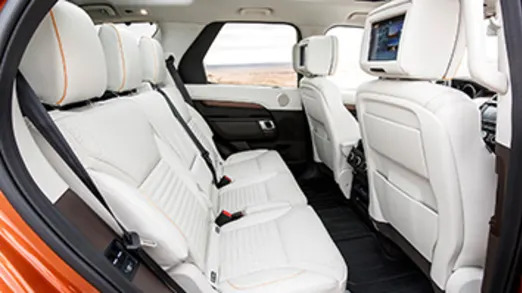
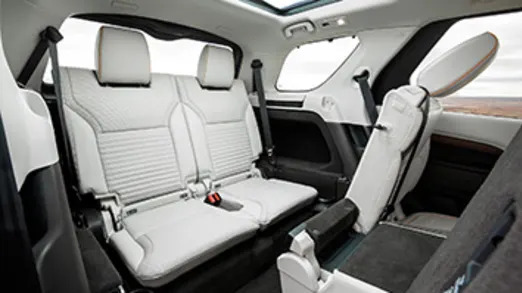

For those mourning the loss of the original's go-anywhere spirit – you few, you happy few, a band of off-roaders – there's a new Defender coming down the pike. It'll land in America, and it'll be as capable as the recently departed one, although that's about as much as we know right now. For everyone else, think of the new Discovery in these terms: The company expects a full 90 percent of 2017 Discovery buyers will be new to the brand, and they'll encounter a handsome SUV that's better on-road than even the softened LR4.
Soft, with better on-road manners – I realize it's a bit practical to admire the new Discovery for what makes it more marketable. There's an ingrained charisma to this SUV, a general Land Rover warmness. The leather is buttery, the steering wheel is meaty and the steering feel direct, the ride is crisp, and sightlines characteristically are excellent. It's no chore to amble up a crooked pass, to roll up its pants and wade through the mud – and presumably effortless to crowd half of a soccer team inside and cross the 'burbs to the field.
So it makes sense to start over. Land Rover has combined what works, left off what isn't necessary, and kept it lighter without becoming lesser – an interstate express for the whole family with European sophistication and American amenities. If that's what you crave, the 2017 Discovery indeed fits the bill.
Related Video:
But rather than softening the LR4 up any more, Land Rover hit the reset button. The 2017 Discovery starts over with its original name but a new philosophy: beginning with a solid foundation of on-road competency and adding back enough off-road capability to pass the laugh test. At least, that's the billing.
To find out how it all works in the real world, I went to southern Utah in the middle of winter. Rain-shrouded mesas and snowy ponderosa pine forests were the backdrop for a broad survey of light off-roading tasks, like scrambling up solid but gently sloping rock faces and blasting through wet sand dunes. Perhaps more importantly, I did long highway stretches through vast open spaces of the Southwest. It feels like a better road machine than its predecessors, partly because Land Rover's astutely perceived the ascendancy of the crossover and built a vehicle for that reality. Onboard WiFi is in, the Camel Trophy is out.




The result is a better Discovery for nearly everyone, and the only casualty is the sentimental baggage attached to a storied name. Even the styling pays only the most trivial deference to its ancestor. The famous multi-window safari roof has evolved into a halfhearted little vestigial hump. The clamshell hood is a more successful adaptation of an original Discovery design feature, spilling down into generously flared fenders in a couple of lovely steps. On the rear hatch, there's a familiar asymmetrical license plate relief and sexy, slim taillights. They do a bit to relieve the eye of the tucked-in hindquarters, which tumble inward from the rear wheels. Surely this is to pull the sheetmetal as tightly and economically around the structure as possible for better aero, but it makes the Discovery look pinched in the rear.
Speaking of structure, the 2017 Discovery doesn't have much in common with the smaller, Evoque-based Discovery Sport. The signature unibody-plus-frame construction of Discoveries past is gone, so the unibody 2017 Discovery is up to 1,000 pounds lighter than its immediate predecessor – a reflection of the reality that older Discoveries lugged around heavy equipment that buyers simply didn't use. It's also 5.5 inches longer than the LR4, with a 1.5-inch-longer wheelbase, and it's marginally lower overall. In a parallel with the original, the new Discovery's aluminum-heavy structure is shared with the full-size Range Rover and the Range Rover Sport. It's stiff as a British upper lip and won't talk about its feelings.




I do have some feelings about the engine choices. The familiar 340-horsepower, supercharged gasoline 3.0-liter V6 is present, as it is in so many JLR products these days. With 332 lb-ft of torque on hand, the blown gas V6 might move the Discovery around effortlessly, but the charismatically torquey turbodiesel V6 is the one that wins you over. Its raw numbers – 254 hp and 443 lb-ft of torque – don't convey it, but the engine is a sweetheart. At a roughly $2,000 premium, the quiet-idling diesel is a worthwhile upgrade. ( The $2,000 upcharge represents the difference in price between the HSE Si6 gas version and the HSE Td6 diesel. The Td6 engine isn't available in the base SE trim. – Ed.)
The only transmission available is the ZF eight-speed automatic, a competent slushbox used in just about everything that matters. In Drive, it's a little protective of fuel economy numbers and loath to do much except upshift as quickly as possible. It wakes up a bit in Sport. With either engine, passing big trucks on the wide-open Utah highway requires only a moderate stab of the throttle and a couple of manual downshifts with the paddles. I spent most of my time in a diesel and observed 25 mpg overall, according to the trip computer.
All-wheel drive is standard, but a low-range transfer case is an option on certain trim levels. That's nothing new; the LR4 offered the same sensible choice to buyers. The low-range option, and what the Discovery can do with it, lend the whole shebang a whiff of go-anywhere legitimacy. Opting for the two-speed 'box gives a standard 50-50 torque split that is then varied electronically depending on conditions, and the truck can shift to low on the fly at up to 37 mph. The single-speed transfer case is a Torsen unit that can vary the torque split to as much as 62 percent front or 78 percent rear; more importantly for efficiency, it offers a 37-pound weight savings.

On the dunes, locking it in low range for the gnarlier stuff reveals the real Achilles' heel of the Discovery: its very on-road oriented tires (Goodyear Eagles, on 20- or 21-inch wheels). I'll hazard a guess that buying knobbier rubber would do more for the Discovery's real-world grip than the low-range case, based on a slightly hairy snow-bound mountain pass encountered along the way. Whatever surface we were on – the pink sand, a muddy and rutted primitive track, or that icy mountain road – the Discovery's Terrain Response 2 electronic traction management system did much of the heavy lifting. That includes the All-Terrain Progress Control system, which is essentially a cautious off-road cruise control system that works hard to control wheelspin at the expense of glacial forward progress. Full autonomous off-roading is surely in the company's future, but the ability to take a nap while your Land Rover works its way to the top of the mountain seems pretty uninteresting.
The optional air suspension provides a useful range of height settings, just like on other JLR products so equipped. From the standard height, it can kneel by a full 2.36 inches when stopped or rise up to 2.95 inches in full off-road lift mode at low speeds. The ride quality in all situations is composed – there's not much head-tossing side-to-side movement, washboard gyrations are well damped, and it doesn't wallow on-road. The suspension and seats easily provide a few hours' worth of comfort before you need to stop for a tea break.
From the front chairs, the view is typical Land Rover, perhaps even typical Range Rover. Since there's a lot of the same DNA here, it's tough to tell just by looking around the cabin that a Range Rover Sport sits higher on the food chain than the Disco in HSE Luxury trim. The futuristic steering wheel and the center console exude a chunky sophistication. The InControl Touch Pro 10.0-inch touchscreen is well integrated, responsive, and intuitive, although its presence means the loss of some convenient physical buttons.



Need to charge a device? There are enough power ports inside – up to nine USB and six 12-volt outlets – to power an Apple Store. There might be 15 storage cubbies inside, if I counted correctly before becoming fascinated by the rear cargo area's party tricks. There are power-folding seat controls back there (the seats can also be operated from the InConnect Touch smartphone app, in case you need to fold down the seats from another county) and a power-operated fold-down tailgate thing since the previous model's split rear hatch has been replaced by a one-piece unit. True to its billing, that tailgate is a great place to sip tea while sheltered from the rain by the overhanging hatch. Behind the tailgate is either a cavernous space or a two-place third-row seat, depending on vehicle configuration and options. With all seats folded flat, there's 82.7 cubic feet, and behind the second row there's 45. That third row is the best you'll find in a Land Rover product, comfortable enough for large children or moderately sized adults.
These capabilities – how the Discovery conquers obstacles of human and nonhuman cargo – are much more important than the window dressing that is the new Discovery's off-road numbers. It can ford even deeper water than the outgoing LR4, actually a rather incredible 7.9-inch increase in wading depth, but Land Rover may as well have taught the SUV to speak Sanskrit. I romped through a few puddles for the hell of it, but I can assure you that if a customer-owned 2017 Discovery finds itself in 35.4 inches of water, there's likely been a tsunami. The same goes for the increased approach and departure angles and improved ground clearance: they're a thin veneer of reassurance rather than a heavy burden.
At $50,985 to start, the 2017 Discovery undercuts the 2017 Mercedes-Benz GLE350 by $2,000, and the lowest-spec 2017 BMW X5 sDrive35i by $5,500 (which is rear-drive), but it's a hair more expensive than the Audi Q7. That being said, the Discovery's third row does a better job of accommodating adults than any of these, as it should being the most specialized people-hauler in the Land Rover lineup. The Range Rover Sport's third row is most definitely an occasional-use proposition, as anyone cross-shopping the two Land Rover seven-seaters will quickly discover.




For those mourning the loss of the original's go-anywhere spirit – you few, you happy few, a band of off-roaders – there's a new Defender coming down the pike. It'll land in America, and it'll be as capable as the recently departed one, although that's about as much as we know right now. For everyone else, think of the new Discovery in these terms: The company expects a full 90 percent of 2017 Discovery buyers will be new to the brand, and they'll encounter a handsome SUV that's better on-road than even the softened LR4.
Soft, with better on-road manners – I realize it's a bit practical to admire the new Discovery for what makes it more marketable. There's an ingrained charisma to this SUV, a general Land Rover warmness. The leather is buttery, the steering wheel is meaty and the steering feel direct, the ride is crisp, and sightlines characteristically are excellent. It's no chore to amble up a crooked pass, to roll up its pants and wade through the mud – and presumably effortless to crowd half of a soccer team inside and cross the 'burbs to the field.
So it makes sense to start over. Land Rover has combined what works, left off what isn't necessary, and kept it lighter without becoming lesser – an interstate express for the whole family with European sophistication and American amenities. If that's what you crave, the 2017 Discovery indeed fits the bill.
Related Video:










Sign in to post
Please sign in to leave a comment.
Continue